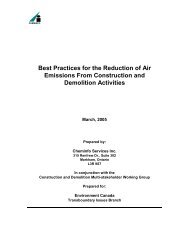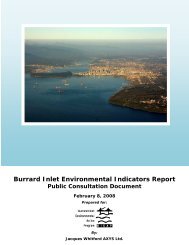Consolidated Environmental Management Plan for Burrard Inlet ...
Consolidated Environmental Management Plan for Burrard Inlet ...
Consolidated Environmental Management Plan for Burrard Inlet ...
Create successful ePaper yourself
Turn your PDF publications into a flip-book with our unique Google optimized e-Paper software.
Traditional Uses of <strong>Burrard</strong> <strong>Inlet</strong><br />
<strong>Burrard</strong> <strong>Inlet</strong>’s natural deep-sea harbour and lowlands<br />
have been a setting <strong>for</strong> successive waves of human<br />
settlement. Centuries ago, <strong>Burrard</strong> <strong>Inlet</strong> constituted<br />
part of the traditional territories of many Coast Salish<br />
peoples, including the Tsleil-Waututh, the Squamish<br />
and the Musqueam Nations. These people utilized the<br />
region’s rich resources such as salmon, clams, mussels,<br />
and eulachon <strong>for</strong> food. They used Douglas fi r, western<br />
red cedar and bark to make homes, canoes, clothes<br />
and other items. A range of berries and aquatic plants<br />
also <strong>for</strong>med important parts of their traditional diet.<br />
Recent discoveries of cultural artefacts at Locarno<br />
Beach and shell midden sites testify to the presence<br />
of First Nations in <strong>Burrard</strong> <strong>Inlet</strong> as early as 500 BC<br />
(Douglas College, Institute of Urban Ecology).<br />
European settlement of <strong>Burrard</strong> <strong>Inlet</strong> began in the mid-<br />
1800s. The <strong>Inlet</strong>’s natural deep harbour accommodated<br />
ocean-going vessels and the fl at topography of the<br />
surrounding lowlands provided an ideal location <strong>for</strong><br />
urban settlement and industrial expansion. In 1863,<br />
the fi rst industrial plant in the Lower Mainland, Pioneer<br />
Sawmills, appeared on the North Shore of <strong>Burrard</strong><br />
<strong>Inlet</strong>. A year later the harbour’s fi rst export cargo<br />
was a shipment of lumber from Pioneer Sawmills<br />
to Australia (FRAP 1998). With the extension of the<br />
transcontinental railway to British Columbia in 1886,<br />
the trans<strong>for</strong>mation of <strong>Burrard</strong> <strong>Inlet</strong> into one of the<br />
largest port operations in North America began.<br />
Urban Pressures on the<br />
<strong>Burrard</strong> <strong>Inlet</strong> Ecosystem<br />
Metro Vancouver is one of the fastest growing areas in<br />
North America and is expected to reach a population<br />
of over 3.1 million by 2031. The southern portion of<br />
<strong>Burrard</strong> <strong>Inlet</strong> is designated as part of the regional<br />
growth concentration area in Metro Vancouver’s<br />
Regional Growth Strategy and will likely absorb a<br />
considerable share of the new population growth. In<br />
addition, Port Metro Vancouver needs to meet the<br />
future demand <strong>for</strong> increased trade and transportation<br />
services. The <strong>Consolidated</strong> <strong>Plan</strong> will help ensure the<br />
continued sustainability and ecological health of<br />
<strong>Burrard</strong> <strong>Inlet</strong> within this rapidly growing urban context.<br />
33<br />
Appendices / <strong>Consolidated</strong> <strong>Environmental</strong> <strong>Management</strong> <strong>Plan</strong> <strong>for</strong> <strong>Burrard</strong> <strong>Inlet</strong>
















